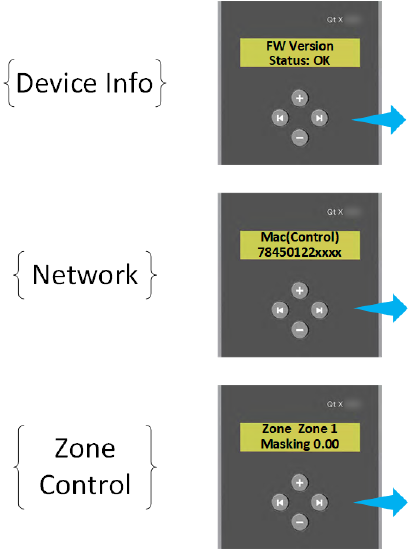Qt X Interacting with hardware
There are 4 options for accessing and configuring Qt X controllers and systems, each with a different of settings that can be viewed or changed.
Interfaces overview
Front Panel
The front panel display and controls of each controller provide basic information and the operating mode of the device.
Web user interface
The onboard web user interface gives installers and users additional access to the networked system and can discover devices, assign outputs to zones, set levels, and manipulate devices in the system. Each controller’s web UI is hosted on the device itself, so the controller must be present and connected to a computer in order to use this interface. The web UI is not suitable for planning a system layout before device connection and deployment. Instead, use the Qt X system management software.
- Note: Current firmware allows for single controller configuration via Web UI. Upon full functionality release, multiple controllers may be added to system and configured together via Web UI.
Qt X software
The Qt X system management software is the most versatile and comprehensive method of controlling a Qt X system. The Qt X software can also help a user design a sound masking system for a location, configure and manage the system settings, control user access levels, and manage system security or protection.
REST Control API
Qt X integrates Representational State Transfer (REST) Application Programming Interface (API), or what's better known as RESTful API. This technology allows end-users to automate the use of Qt X to match the custom needs of an organization. Use of this documentation assumes an end-user is comfortable using APIs, can use programming tools such as curl, and are competent at writing code using programming language libraries.
Note: Qt X support via SageVue management and monitoring application is planned for a future release.
Front panel details
These function can be accessed or editied on front panel of a Qt X controller: 
- FW version number
- Fault status message
- Hostname
- MAC address (Control)
- IP Address (Control)
- Netmask (Control)
- MAC Address (Media)
- IP Address (Media)
- Netmask (Media)
- Zone Audio levels (Masking, Background, Paging)
Note: Clearing configuration and emitter type selection are not available via the front panel controls.
Qt X Web UI
The onboard web user interface allows access or control of:
- Discover devices and assign them to a system

- Configure a sound masking system
- Create zones and assign outputs to them
- Define the Logic I/O for each controller
- Add and/or configure Audio sources
- Manage and configure Inputs, Zones, and Outputs
- Manage schedule and "Soft Start" planning
- View status and send changes to Zones, Devices, Faults, Outputs, Date/ Time and System Info
- View or make changes to system, device and network settings
- Update firmware
- Set user security and access levels
Not supported via Web UI:
- Bulk FW updates
- Importing and utilization of a floor plan image
- Save and upload a .qdd system file
- Manage custom certificates
- Manage 802.1X
- When future NPX integration is supported, software will be required for utilization of NPX (for setup and configuration)
Qt X System management software
When released, this software will provide the following design and control elements:
 Design a sound masking system
Design a sound masking system
- Import a floor plan
- Add / Configure Zones
- Add / Configure Qt X Controllers
- Add Emitters or Speakers
- Connect emitters to controller outputs
- Save the system configuration
- Discover devices
- Configure a system
- Assign outputs to zones
- Rename Devices
- Assign Audio Sources
- Configure and send system settings
- Define / Change system properties
- Filter and group systems and devices
- Adjust Output and system Zone levels, including changing individual and batched sound masking or streamed audio settings to a live system
- Manage schedule and "Soft Start" planning
- Update Firmware
- Define system security, passwords and user access settings - Qt X devices are shipped in an 'unprotected' state to allow installers to configure and use the device without requiring explicit authentication or authorization
- View and manage security certificates
Qt X control via RESTful API
Qt X integrates Representational State Transfer (REST) Application Programming Interface (API), or what's better known as RESTful API. This technology allows end-users to automate the use of Qt X to match the custom needs of an organization. Use of this documentation assumes an end-user is comfortable using APIs, can use programming tools such as curl, and are competent at writing code using programming language libraries.

